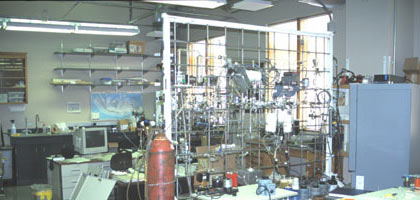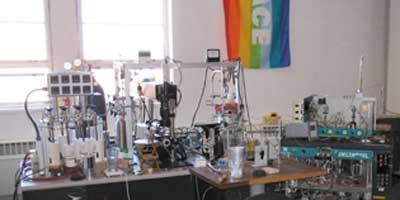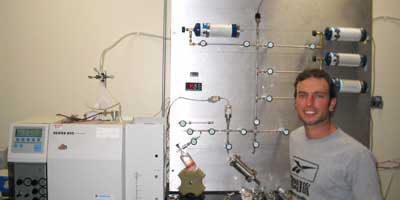| SCRIPPS INSTITUTION OF OCEANOGRAPHY, UCSD |

| the expedition | |
| the science | |
| tools & techniques | |
| japanese life | |
| daily journal | |
| the team | |
|
:: VOLCANOES :: Fuji Hakone Oshima Nii-Jima • Shikinejima Hachijo-Jima Aoga-Shima |
|
|||||||||||||||||||||||||||||||||||||||||||||||||||||||||||||||||||||||||||||||||||||||||||||||||||||||||
Gas Chemistry

It is critical for the success of the project to collect the best possible samples in the field. Only with good samples, that have not been compromised by any air contamination, will we be able to obtain the information that we are after. Even the best and most sophisticated analytical techniques are useless if the sample has not been collected very carefully. Once back in the laboratory we perform three types of analyses.
At the University of New Mexico we analyze the chemical composition of the gases. In this way we will determine the amount of water, carbon dioxide, sulfur dioxide, methane, nitrogen, hydrogen, carbon monoxide, argon and helium in the sample. Because the Giggenbach bottle contains two parts - the solution and the 'head space gas' - we will use two types of techniques to analyze the sample. The solution is analyzed by general wet chemical techniques, such as titrations. The 'head space gas' is analyzed by a gas chromatograph specifically designed to determine the species of interest. The gas chromatograph has a column that works essentially like a sieve. When the sample is introduced into this column the species become separated based on their size. For example helium and hydrogen are very small atoms and they will go through the sieve very quickly. Methane and carbon dioxide are much larger and they get stuck in the sieve for longer. On the other end of the sieve we have a detector that determines the concentration of the species that have been previously separated by the column.

nitrogen isotopic composition
At the University of New Mexico we also analyze the isotopic composition of nitrogen using a stable isotope mass spectrometer. From the Giggebach bottle, we take a small part of the gas and introduce it into another column similar to the sieve used in the gas chromatograph. The gas mixture is introduced into this column but on the other end of the column we have not simply a detector but a mass spectrometer. Once the nitrogen comes through the column it gets into the mass spectrometer where the different isotopes of nitrogen are separated by their differences in mass. In the case of nitrogen, there are two isotopes - nitrogen 14 and nitrogen 15 - because each has a slightly different mass we can determine the relative amounts - or the nitrogen 15 to nitrogen 14 ratio of our samples very precisely using the mass spectrometer.

At Scripps Institution of Oceanography, the third set of analyses is performed on the gas samples collected in the small bottles. Here the focus is on the isotopic composition of helium and carbon of the carbon dioxide. Helium, a noble gas, has two isotopes - helium 3 and helium 4. They have slightly different masses and to determine the ratio of helium 3 to helium 4 we use a noble gas mass spectrometer. It is similar in the case of carbon. Carbon has three isotopes: carbon 12, carbon 13 and carbon 14. For our study we are only interested in carbon 12 and carbon 13. Carbon 14 is produced by radioactive decay and is used for determining the age of rocks, for example. Again, the carbon dioxide gets introduced to a mass spectrometer and because of the slightly different weights of each isotope, we can determine the ratio of carbon 13 to carbon 12 in our gas samples.
